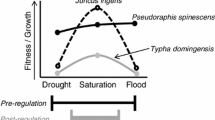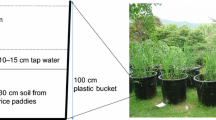Abstract
Agriculture and urbanization in the upland landscape often generate stressors, such as sedimentation and eutrophication, that may negatively impact wetland plant communities. Individual plant species responses to stressors are also likely influenced by the hydrologic and geomorphologic characteristics of different wetland hydrogeomorphic (HGM) subclasses. The goal of this study was to determine to what extent the two stressors listed above influence the growth and development of wetland plant species and how these responses vary across HGM subclasses. The impacts of the two stressors on wetland plant species emergence and growth were examined in a 2 × 2 factorial greenhouse experiment, using soil moisture and organic matter content to simulate three HGM subclasses. Both stressors elicited significant responses in species establishment and growth, but overall trends in stressor responses differed by wetland type. For instance, sedimentation reduced the emergence of four species in simulated riparian depressions but only affected one species in simulated slope wetlands and none in simulated headwater floodplains. Sedimentation had little impact on any species establishment or growth in headwater floodplains. Approximately half of the species showed an increase in at least one growth variable in response to nitrogen enrichment. Additionally, the conditions used to simulate HGM subclasses appeared to impact a species performance and sensitivity to stressors. Therefore, further investigation of the impacts of HGM subclass conditions on species performance is needed. We expected differences in species responses to be related to their natural distribution across pristine and impacted wetlands; however, no obvious relationships were found. Our results suggest that it will be difficult to make generalizations about species responses to stressors because responses varied by stressor type, stressor interactions, and HGM subclass. Therefore, perhaps the next step in formulating broad generalizations and predictions about wetland plant community composition will require a shift from species-based approaches to a trait-based approach for examining how species composition may change in response to future disturbances.
Similar content being viewed by others
Literature Cited
Adamus, P. R. and K. Brandt. 1990. Impacts on quality of inland wetlands of the United States: a survey of indicators, techniques, and application of community-level biomonitoring data. Office of Research and Development, U.S.. Environmental Protection Agency, Washington, DC, USA. EPA/600/3-90/073.
Alberts, E. E. and R. G. Spomer. 1985. Dissolved nitrogen and phosphorus in runoff from watersheds in conservation and conventional tillage. Journal of Soil and Water Conservation 40:153–157.
Baskin, C. C. and J. M. Baskin. 1998. Seeds—Ecology, Biogeography, and Evolution of Dormancy and Germination. Academic Press, New York, NY, USA.
Bewley, J. D. and M. Black. 1994. Seeds—Physiology of Development and Germination. Plenum Press, New York, NY, USA.
Bishel, L. 1994. Soil properties of natural reference wetlands and wetland mitigation projects in Pennsylvania. M.S. Thesis. The Pennsylvania State University, University Park, PA, USA.
Bishel-Machung, L., R. P. Brooks, S. S. Yates, and K. L. Hoover. 1996. Soil properties of reference wetlands and wetland creation projects in Pennsylvania. Wetlands 16:532–541.
Bonis, A. and J. Lepart. 1994. Vertical structure of seed banks and the impact of depth of burial on recruitment in two temporary marshes. Vegetatio 112:127–139.
Brooks, R. P. and D. H. Wardrop. 2000. Quality assurance project plan addendum for development and assessment protocols for determining wetland inventory and the ecological condition of watersheds in the Juniata River watershed. U.S. Environmental Protection Agency. Corvallis OR, USA. Internal report CR826662-01-0.
Brooks, R. P., D. H. Wardrop, and J. A. Bishop. 2002. Watershed-based protection for wetlands in Pennsylvania: Levels 1 & 2— Synoptic maps and rapid field assessments. Final Report to Pennsylvania Department of Environmental Protection, Penn State Cooperative Wetlands Center, Pennsylvania State University, University Park, PA, USA. Report No. 2002-2.
Casanova, M. T., and M. A. Brock. 2000. How do depth, duration and frequency of flooding influence the establishment of wetland plant communities? Plant Ecology 147:237–250.
Chapin, F. S., A. J. Bloom, C. B. Field, and R. H. Waring. 1987. Plant responses to multiple environmental factors. BioScience 37:49–57.
Cole, C. A., R. P. Brooks, and D. H. Wardrop. 1997. Wetland hydrology as a function of hydrogeomorphic (HGM) subclass. Wetlands 17:456–467.
Cole, C. A. and R. P. Brooks. 2000. Patterns of wetland hydrology in the Ridge and Valley province, Pennsylvania, USA. Wetlands 20:438–447.
Crumpton, W. G., T. M. Isenhart, and S. W. Fisher. 1993. Fate of non-point source nitrate loads in freshwater wetlands: results from experimental wetland mesocosms. p. 283–291. In G. A. Moshiri (ed.) Constructed Wetlands for Water Quality Improvement. Lewis Publishers, Inc., Chelsea, MI, USA.
Derkx, M. P. M. and C. M. Karssen. 1993. Changing sensitivity to light and nitrate but not gibberellins regulates seasonal dormancy patterns in Sisymbrium officinale seeds. Plant, Cell and Environment 16:469–479.
Dittmar, L. A. and R. K. Neely. 1999. Wetland seed bank response to sedimentation varying in loading rate and texture. Wetlands 19:341–351.
Freeland, J. A., J. L. Richardson, and L. A. Foss. 1999. Soil indicators of agricultural impacts on northern prairie wetlands: Cottonwood Lake Research Area, North Dakota, USA. Wetlands 19:56–64.
Galatowitsch, S. M., N. O. Anderson, and P. D. Ascher. 1999. Invasiveness in wetland plants in temperate North America. Wetlands 19:733–755.
Galatowitsch, S. M., D. C. Whited, R. Lehtinen, J. Husveth, and K. Schik. 2000. The vegetation of wet meadows in relation to their land-use. Environmental Monitoring and Assessment 60:121–144.
Gleason, H. A. and A. Cronquist. 1991. Manual of Vascular Plants of the Northeastern United States and Adjacent Canada. The New York Botanical Garden. Bronx, NY, USA.
Goldberg, D. E. and T. E. Miller. 1990. Effects of different resource additions on species diversity in an annual plant community. Ecology 71:213–225.
Jurik, T. W., S.-C. Wang, and A. G. van der Valk. 1994. Effects of sediment load on seedling emergence from wetland seed banks. Wetlands 14:159–165.
Karssen, C. M. and H. W. M. Hilhorst. 1992. Effect of chemical environment on seed germination. p. 327–348. In M. Fenner (ed.) Seeds—The Ecology of Regeneration in Plant Communities. C.A.B. International, Oxfordshire, UK.
Leck, M. A. 1996. Germination of macrophytes from a Delaware River tidal freshwater wetland. Bulletin of the Torrey Botanical Club 123:48–67.
Lenssen, J. P. M., G. E. ten Dolle, and C. W. P. M. Blom. 1998. The effects of flooding on the recruitment of reed marsh and tall forb plant species. Plant Ecology 139:13–23.
Lepš, J. 1999. Nutrient status, disturbance and competition: an experimental test of relationships in a wet meadow. Journal of Vegetation Science 10:219–230.
Mahaney, W. M. 2001. Impacts of human-mediated stressors on wetland plant community development. M.S. Thesis. The Pennsylvania State University, University Park, PA, USA.
Mahaney, W. M., D. H. Wardrop, and R. P. Brooks. 2004. Impacts of sedimentation and nitrogen enrichment on wetland plant community development. Plant Ecology 175:(in press).
Neely, R. K. and J. A. Wiler. 1993. The effect of sediment loading on germination from the seed bank of three Michigan wetlands. The Michigan Botanist 32:199–207.
Owens, L. B., W. M. Edwards, and R. W. van Keuren. 1984. Peak nitrate-nitrogen values in surface runoff from fertilized pastures. Journal of Environmental Quality 13:310–312.
Reich, P. B., D. Tilman, J. Craine, D. Ellsworth, M. G. Tjoelker, J. Knops, D. Wedin, S. Naeem, D. Bahauddin, J. Goth, W. Bengtson, and T. Lee. 2001. Do species and functional groups differ in acquisition and use of C, N and water under varying atmospheric CO2 and N availability regimes? A field test with 16 grassland species. New Phytologist 150:435–448.
Reinhardt, C. H. 1999. Historical analysis of wetland plant community response to disturbance. M.S. Thesis. The Pennsylvania State University, University Park, PA, USA.
Schütz, W. and G. Rave. 1999. The effect of cold stratification and light on seed germination of temperate sedges (Carex) from various habitats and implications for regenerative strategies. Plant Ecology 144:215–230.
Sjörs, H. 1991. Phyto- and necromass above and below ground in a fen. Holarctic Ecology 14:208–214.
Thormann, M. N. and S. E. Bayley. 1997. Response of aboveground net primary plant production to nitrogen and phosphorus fertilization in peatlands in Southern Boreal Alberta, Canada. Wetlands 17:502–512.
Tilman, D. 1984. Plant dominance along an experimental nutrient gradient. Ecology 65:1445–1453.
Tilman, D.. 1987. Secondary succession and the pattern of plant dominance along experimental nitrogen gradients. Ecological Monographs 57:189–214.
USDA, NRCS. 2001. The PLANTS Database, Version 3.1 (http://plants.usda.gov). National Plant Data Center, Baton Rouge, LA, USA.
van der Valk, A. G. 1981. Succession in wetlands: a Gleasonian approach. Ecology 62:688–696.
Verhoeven, J. T. A. and M. B. Schmitz. 1991. Control of plant growth by nitrogen and phosphorus in mesotrophic fens. Biogeochemistry 12:135–148.
Vermeer, H. G. 1986. The effect of nutrients on shoot biomass and species composition of wetland and hayfield communities. Acta Ecologica 7:31–41.
Vitousek, P. M. and R. W. Howarth. 1991. Nitrogen limitation on land and in the sea: how can it occur? Biogeochemistry 13:87–116.
Vought, L. B-M., J. Dahl, C. L. Pedersen, and J. O. Lacoursière. 1994. Nutrient retention in riparian ecotones. Ambio 23:342–348.
Wang, S.-C., T. W. Jurik, and A. G. van der Valk. 1994. Effects of sediment load on various stages in the life and death of cattail (Typha X glauca). Wetlands 14:166–173.
Wardrop, D. H. 1997. The occurrence and impact of sedimentation in central Pennsylvania wetlands. Ph.D. Dissertation. The Pennsylvania State University, University Park, PA, USA.
Wardrop, D. H. and R. P. Brooks. 1998. The occurrence and impact of sedimentation in central Pennsylvania wetlands. Environmental Monitoring and Assessment 51:119–130.
Author information
Authors and Affiliations
Corresponding author
Rights and permissions
About this article
Cite this article
Mahaney, W.M., Wardrop, D.H. & Brooks, R.P. Impacts of stressors on the emergence and growth of wetland plant species in Pennsylvania, USA. Wetlands 24, 538–549 (2004). https://doi.org/10.1672/0277-5212(2004)024[0538:IOSOTE]2.0.CO;2
Received:
Revised:
Accepted:
Issue Date:
DOI: https://doi.org/10.1672/0277-5212(2004)024[0538:IOSOTE]2.0.CO;2




